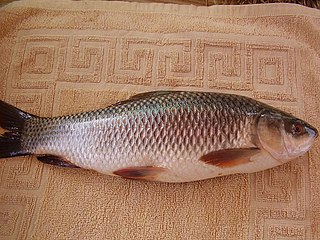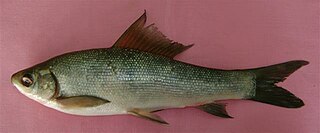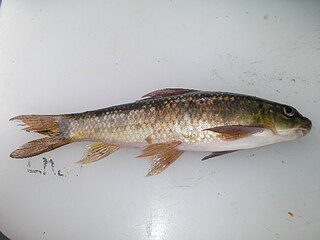
The rohu, rui, or roho labeo is a species of fish of the carp family, found in rivers in South Asia. It is a large omnivore and extensively used in aquaculture.

Catla, also known as the major South Asian carp, is an economically important South Asian freshwater fish in the carp family Cyprinidae. It is native to rivers and lakes in northern India, Bangladesh, Myanmar, Nepal, and Pakistan, but has also been introduced elsewhere in South Asia and is commonly farmed.

Labeo is a genus of carps in the family Cyprinidae. They are found in freshwater habitats in the tropics and subtropics of Africa and Asia.
The Fuelleborn's labeo is an African species of freshwater fish in the family Cyprinidae. It is found in Burundi and Tanzania in the Lake Rukwa basin, Lake Tanganyika and the Malagarasi River. Its natural habitats are rivers, freshwater lakes, and inland deltas. Its status is insufficiently known.

The Ewaso Nyiro labeo is an African species of freshwater fish in the family Cyprinidae. It is found only in Kenya. Its natural habitat is rivers.
Labeo trigliceps is a species of ray-finned fish in the family Cyprinidae. It is found only in the Athi River in Kenya. Its natural habitat is rivers. Its taxonomic status is uncertain and the specimens taken so far may be aberrant specimens of Labeo cylindricus.

The Kuria labeo is a species of fish in the carp family, Cyprinidae. It is native to Pakistan, India, Bangladesh, and Burma, and it is known from Afghanistan and Nepal.

The orangefin labeo is a fish of the carp family Cyprinidae, found commonly in rivers and freshwater lakes in and around South Asia and South-East Asia. Native to Bangladesh and India.

The rednose labeo is a species of fish in the family Cyprinidae, the carps and minnows. Other common names include Hunyani labeo, Manyame labeo, rednose mudsucker, and sailfin mudsucker. It is native to Africa, where it is distributed in the Democratic Republic of the Congo, Malawi, Mozambique, Zambia, and Zimbabwe.

The fringed-lipped peninsula carp is a cyprinid fish in genus Labeo from Pakistan, India, Nepal, Bangladesh and Myanmar. It is listed as Least Concern in the global IUCN Red List of threatened species.

The redeye labeo is a species of fish in the cyprinid genus Labeo. It is a freshwater fish endemic to the rivers of East Africa, from the Zambezi through the Limpopo and Komati Rivers to the Pongola River. It also inhabits upper and middle parts of the Congo River.

The Cunene labeo or Kunene labeo is a species of fish in the family Cyprinidae, the carps and minnows. It is native to Angola and Namibia.

The boxlip mullet is a species of fish in the mullet family which is found in the eastern Atlantic from Gibraltar to Morocco, it is found in the Mediterranean Sea but not the Black Sea. It is the only species in the monospecific genus Oedalechilus.
Labeo camerunensis is a species of freshwater fish belonging to the genus Labeo. It is found in the Mungo River in western Cameroon.
Labeo chariensis is a species of freshwater fish belonging to the genus Labeo. It is found in the Congo River basin.
Labeo djourae is a species of freshwater fish belonging to the genus Labeo. It is endemic to the Benue River in Chad. It is sometimes considered conspecific with Labeo parvus.
Labeo lividus is a species of freshwater fish belonging to the genus Labeo. It is found in the lower Congo River. It is sometimes considered conspecific with Labeo barbatus.
Labeo ricnorhynchus is a species of freshwater fish belonging to the genus Labeo. It is endemic to India.
Labeo vulgaris is a species of freshwater fish belonging to the genus Labeo. It is endemic to Egypt. It is sometimes considered conspecific with Labeo niloticus.









